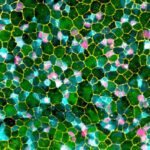Link to Pubmed [PMID] – 19003874
J. Comp. Neurol. 2009 Jan;512(2):158-82
Serotonin is a major central nervous modulator of physiology and behavior and plays fundamental roles during development and plasticity of the vertebrate central nervous system (CNS). Understanding the developmental control and functions of serotonergic neurons is therefore an important task. In all vertebrates, prominent serotonergic neurons are found in the superior and inferior raphe nuclei in the hindbrain innervating most CNS regions. In addition, all vertebrates except for mammals harbor other serotonergic centers, including several populations in the diencephalon. This, in combination with the intricate and wide distribution of serotonergic fibers, makes it difficult to sort out serotonergic innervation originating from the raphe from that of other serotonergic cell populations. To resolve this issue, we isolated the regulatory elements of the zebrafish raphe-specific gene pet1 and used them to drive expression of an eGFP transgene in the raphe population of serotonergic neurons. With this approach together with retrograde tracing we 1) describe in detail the development, anatomical organization, and projection pattern of zebrafish pet1-positive neurons compared with their mammalian counterparts, 2) identify a new serotonergic population in the ventrolateral zebrafish hindbrain, and 3) reveal some extent of functional subdivisions within the zebrafish superior raphe complex. Together, our results reveal for the first time the specific innervation pattern of the zebrafish raphe and, thus, provide a new model and various tools to investigate further the role of raphe serotonergic neurons in vertebrates.

